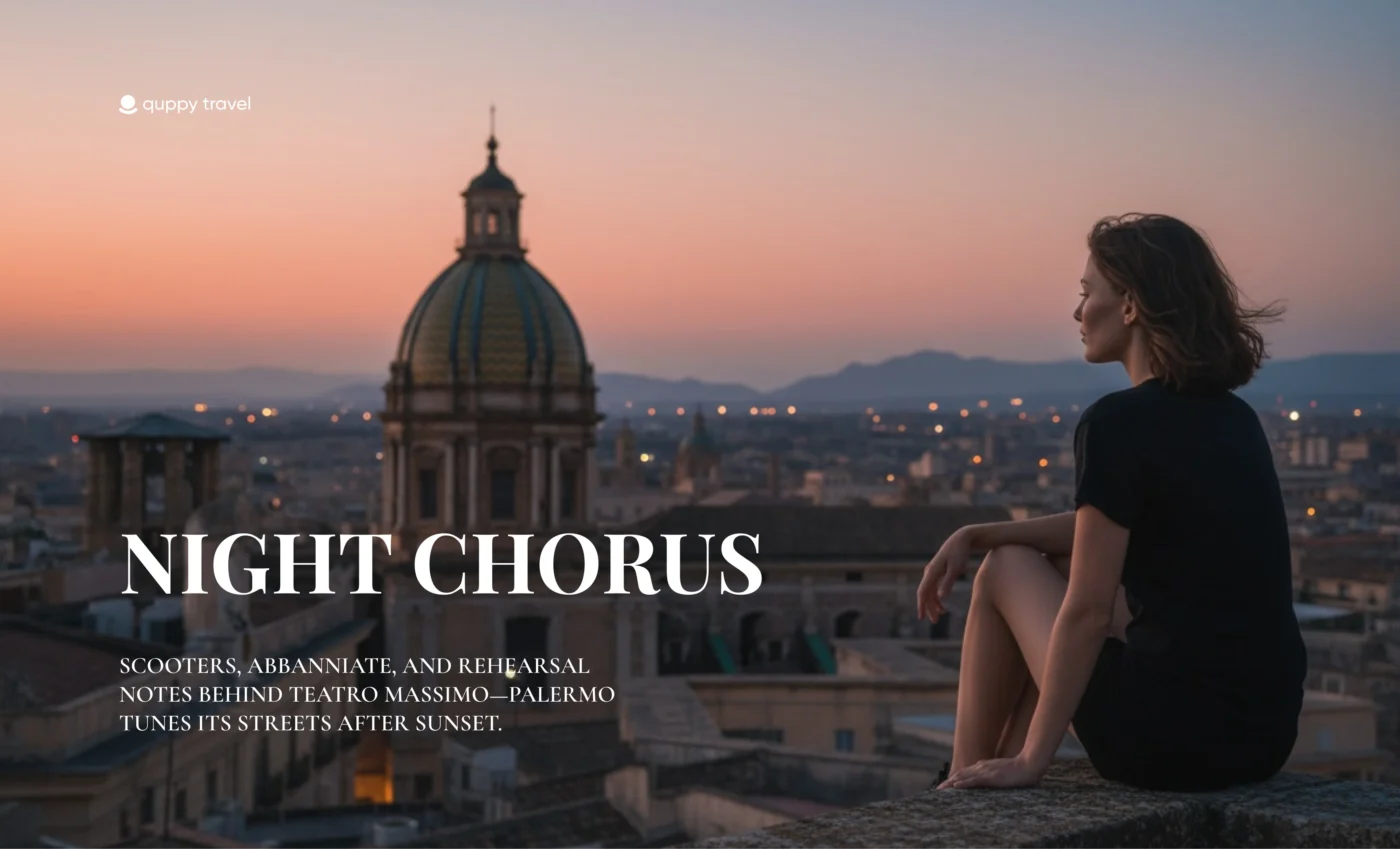Food
Food Categories, unlike tags, can have a hierarchy. You might have a Jazz category.
Search
Food Categories, unlike tags, can have a hierarchy. You might have a Jazz category.
Review Categories, unlike tags, can have a hierarchy. You might have a Jazz category.
Guides Categories, unlike tags, can have a hierarchy. You might have a Jazz category.
Travel Categories, unlike tags, can have a hierarchy. You might have a Jazz category.
![]() By Quppy
By Quppy

A city scored in minor keys: muezzin echoes fossilized in stone, Baroque trumpets gilding the air, and a chorus of market sellers calling your name.
Palermo hums in contradictions that feel perfectly at ease together. Arab domes sit beside Baroque façades; citrus groves bleed into concrete; street food smoke curls past palaces. If Rome is a museum and Milan a runway, Palermo is a rehearsal room—alive, imperfect, impossible to fake.
If you want to understand Palermo, start with its markets. Ballarò wakes early—crates of blood oranges and swordfish flash like stage lights while vendors sing abbanniate, the musical chants that reel you in. By midday, Il Capo becomes a tight little theater of glistening anchovies, basil, and zucchini blossoms. And when the sun backs off, Vucciria takes over—shabby, loud, irresistible, and forever haunted by Renato Guttuso’s iconic painting.
Eat what locals eat: a slab of sfincione (thick, oregano-heavy “pizza” long before New York took notes); pane e panelle (fried chickpea fritters in bread, a legacy of Arab chickpea culture); a smoky stigghiola skewer (grilled, herbed lamb intestines—yes, order one); and Palermo’s pride, the round arancina (here it’s -a, not -o), saffron rice in a crisp shell, often stuffed with ragù or pistachio cream. If you’re feeling brave and very Sicilian, say yes to pani câ meusa, the spleen-and-ricotta sandwich that tastes like the port—salty, iron, unforgettable.
Insider cue: Markets are largely cash-first. Keep small notes for stalls; card machines sulk when the sun is high.
Palermo’s greatest story is told in mosaic and muqarnas. Inside the Cappella Palatina (in the Palazzo dei Normanni), a honeycomb wooden ceiling of Islamic craft hangs above Byzantine Christ Pantocrator, flanked by Latin inscriptions—three civilizations sharing one breath. Step outside to San Cataldo, crowned with three red domes like pomegranates, then to La Martorana, where 12th-century mosaics glitter as if plugged into a secret sun.
Follow the thread to the summer palaces—La Zisa (“the splendid”) and La Cuba—set in what was once the Conca d’Oro, a golden basin of citrus. Their cooling halls and water channels are less museum, more memory of an Arab court. End at the Cathedral, a collage of centuries: Norman bones, Arab ornament, Baroque swell. It shouldn’t work. It absolutely does.
Quiet marvel: In the Palatine Chapel, look up until you lose track of time. The muqarnas ceiling isn’t decoration; it’s geometry turned into prayer.
Palermo loves its protectors. In July, the city keeps faith with Santa Rosalia—a torchlit procession climbs Monte Pellegrino to a cavernous sanctuary, and fireworks argue with the sea. Elsewhere, the Opera dei Pupi (Sicilian marionettes) still duel on tiny stages; chivalric epics arrive with wood, strings, bravado.
Then there are the rooms you whisper in: the Catacombe dei Cappuccini, miles of mummified Palermitans—merchants, children, brides—dressed for an afterlife of looking. The famous Rosalia Lombardo lies almost sleeping, a century-old miracle of preservation. Go gently; this is a city’s family album, not a horror film.
For your ears: Stand behind Teatro Massimo at dusk and catch the spill of rehearsal—Palermo puts music in the alleyways, too.
In La Kalsa (the old Arabic quarter), walls do double duty as canvases—murals bloom on peeling plaster; laundry writes its own flags. Stroll to Foro Italico for a sea wind and then drift back through Piazza Marina under the tentacled roots of ancient ficus trees. Peek into Palazzo Butera, rescued and reborn—baroque bones hosting contemporary art and talks that stretch into aperitivo.
When the city sweats, escape to Mondello—a crescent of pale sand between green-blue shallows and liberty-style villas. Closer in, the little port of La Cala turns masts into a forest at sunset; order a spritz and watch the water go pink, then dark.
Small ritual: Breakfast on granita with brioche col tuppo isn’t just for the island’s east. In Palermo, lemon or mulberry granita steals the show on hot mornings.
Everyone knows cannoli and cassata, but Palermo’s pantry runs deeper. Try sarde a beccafico—sardines rolled with breadcrumbs, pine nuts, and raisins, an Arab echo rendered Sicilian. Hunt down pasta con le sarde (fennel, sardines, saffron, wildness) when it’s in season. Pair with a cold Grillo or a saline Catarratto and you’ll taste the island’s geology in the glass.
For dessert, ask for cannoli from Piana degli Albanesi (short drive, big payoff) and a splash of Passito di Pantelleria—sun-dried sweetness that tastes like August saved in a bottle.
Cook’s note: December 13 (Santa Lucia) is prime time for arancine day—bakeries turn into rice laboratories.
Palermo is a choreography: early markets, slow noon, electric night. Churches welcome shoulders and knees covered; markets welcome curiosity and a hand on your bag. Walk most places; buses and the tram fill the gaps; taxis are useful late. You won’t see everything. That’s not a bug.
Pay like you belong: With Quppy Travel, keep euros effortless. Quppy Wallet lets you top up EUR from crypto, split an over-ambitious street-food run with friends, or handle museum tickets and hotel deposits without FX surprises. Keep coins for abbanniate charm; let Quppy do the quiet work in the background so your hands are free for sfincione and camera.
Cities often ask to be admired. Palermo asks to be believed. It hands you a lemon leaf, a mosaic shard, a bass note from a Vespa, a story someone’s grandmother swears is true. You leave with pockets full of proof—and a promise to come back for the parts you missed on purpose.